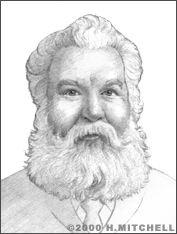Alexander Bell
When the word "inventor" is mentioned, Alexander Graham Bell, creator of the telephone, is undoubtedly one of the first names that springs to mind.
Bell was born on March 3, 1847 in Edinburgh, Scotland and was educated at the University of Edinburgh and the University of London. He immigrated to Canada in 1870 and to the United States in 1871. He was an early student of sound and speech, inspired, perhaps, by the fact that his mother, Eliza, was almost totally deaf, and his father, Melville, developed the first international phonetic alphabet. In his early 20s, Bell himself taught deaf children to speak and gave speech lessons at schools in his community.
As a boy, Bell built a speaking robot and found that he could touch his dog's throat in ways that seemed to form his barks and growls into words. Once, he successfully obtained a human ear from a medical school, which he used to conduct experiments tracing sound patterns. Bell was also a gifted pianist, who learned to discriminate pitch very well. As a teenager, he noticed that a chord struck on a piano in one room would be echoed by a piano in another room. He realized that chords could be transmitted through the air, vibrating at the other end at exactly the same pitch.
With this discovery, Bell set out to develop a multiple telegraph, using Morse code to convey several messages simultaneously, each at a different pitch. He knew his greatest challenge would be finding a way to convey pitch across a wire. He ascertained, eventually, that this could be accomplished by reproducing sound waves in a continuous, undulating current. That's when he realized that this could also apply to human speech, which is composed of many complex sound vibrations.
In 1875, Bell developed his first version of what came to be known as the telephone. He received a patent for it on March 7, 1876, just after his 29th birthday. Five days later, on March 12, he tested his device, speaking into the phone to his associate, Thomas Watson, when he said, "Mr. Watson, come here. I want to see you."

Bell first demonstrated his most famous invention on June 25, 1876 at the Centennial Exhibition in Philadelphia. There, he showed that the sound of the human voice could be reproduced, which confirmed his theory that speech patterns can be made to change the intensity of an electrical current.
A year after Bell's initial public demonstration, he placed the world's first phone call over telegraph wires between two towns in Ontario, Canada – a span of eight miles. Just two months later, the long-distance reach of telephone technology was expanded to 143 miles. Today, of course, telephone calls may be placed to virtually any location around the globe. The Bell Telephone Company was established in 1877 to bring telephones to the masses. The company provided the foundation for today's telecommunications industry.
While Bell is best known for his telephone invention, he worked on hundreds of projects throughout his life and received a number of patents in various fields.
In 1880, Bell patented the photophone, which applied his telephone principle in order to transmit words on a beam of light. This has been recognized as the first wireless transmission of speech. Not until more than a century later would this idea have any widespread use. The principles behind the process enabled the development of what we know today as the cellular phone.
Bell was also an aviation enthusiast. He worked on designs for airplanes, kites, and helicopters with members of the Aerial Experiment Association. In 1909, Bell's Silver Dart airplane flew for a half mile in Baddeck, Nova Scotia, six years after the Wright Brothers took their first flight in North Carolina. Later, Bell developed the tetrahedron while he worked on the design for a kite that could carry a man. The figure, made up of four equilateral triangles, is one of nature's most stable structures and forms the basis for many modern bridges and towers. At the age of 75, Bell received a patent on one of the fastest watercrafts in the world, the HD-4.
To sum up his approach to invention, Bell once said, "Leave the beaten track behind occasionally and dive into the woods. Every time you do you will be certain to find something that you have never seen before. Follow it up, explore all around it, and before you know it, you will have something worth thinking about to occupy your mind."
Bell died August 2, 1922, in Cape Breton Island, Nova Scotia, Canada. His notebooks are still available for public consultation. Researchers believe his early ideas may still hold clues that can help provide the solutions for modern technological problems.


